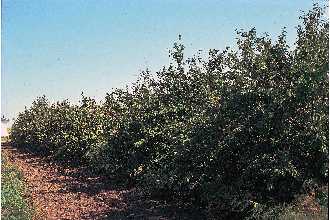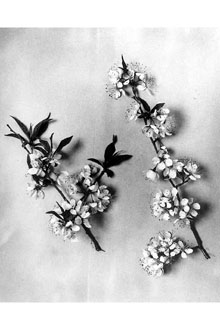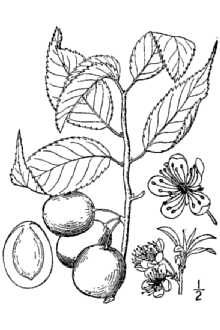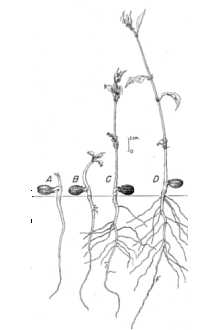American Plum
Scientific Name: Prunus americana Marshall

| General Information | |
|---|---|
| Usda Symbol | PRAM |
| Group | Dicot |
| Life Cycle | Perennial |
| Growth Habits | ShrubTree, |
| Native Locations | PRAM |
Plant Guide
Alternative Names
American plum, American wild plum, sandhill plum, Osage plum, river plum, sand cherry, thorn plum, wild yellow plum, red plum, August plum, goose plum, hog plum, and sloe , Use soil moisture sensors to measure the soil moisture of American Plum.
Uses
Ethnobotanic: Wild plum fruit was and still is extensively consumed by the Indians of the prairies, either fresh or made into a sauce (Kindscher 1987). The Pawnee, Kiowa, Comanche, Omaha, Teton Dakota, Lakota, Comanche, Crow, Assiniboin, and Kiowa ate the wild plums or chickasaw plums (Prunus angustifolia) fresh or dried. Plums were also pitted and dried, although the Pawnee reportedly often dried them without removing the pits (Gilmore 1977). Early explorers and travelers of the Prairie Bioregion often mentioned wild plums in their journals and diaries and also appreciated them as food (Kindscher 1987). Today wild plums are eaten fresh, canned, preserved in jams and jellies, baked, and made into fruit roll-ups. The Omaha scraped and boiled the bark from the roots of the wild plum and applied it to abrasions (Gilmore 1977, Kindscher 1992). They bound together the twigs of the wild plum and made them into a broom. The Cheyenne mixed the crushed fruits of the wild plum with salt to treat mouth disease (Hart 1981). They also crushed and boiled the small rootlets and the bark of older wild plum with the roots of the scarlet thorn (Crataegus chrysocarpa) as a diarrhea remedy (Youngken 1925). The Mesquakies used the root bark of the wild plum to cure canker sores around the mouth (Smith 1928). Mike Clayton @ Imhoff (2000) The Teton Dakota used the sprouts or young growth of the wild plum as a wand in the “waunyampi” ceremony (Gilmore 1977). This is an offering or form of prayer, consisting of a wand made from a peeled and painted wild plum sprout. The “waunyampi” ceremony is usually offered with prayers for the sick. The various species of wild plum are astringent and sedative, and the bark is a tonic (Smythe 1901). The roots and bark contain a bitter substance as well as a substance called phloretin, which is an active agent against gram positive and negative bacteria (Lewis and Elvin-Lewis 1977). Wildlife: Wild plums are eaten by turkey, black bear, and wolves (Thwaites 1904). Foxes, black-headed grosbeaks, and ring-tailed cats utilize wild plums (Martin et al. 1951). Plum thickets often furnish valuable protective shelter. Conservation: Wild plums have been recommended for their drought resistance and widely planted in shelter belts in the western Great Plains (Jerry Kaiser pers. comm. 1999). They also make good wildlife habitat and are effective in erosion control because their roots hold the soil. Their thorny branches catch tumbleweeds, leaves, and other plant materials, which, when windstorms occur during times of drought, provide an effective means of slowing wind erosion of soil.
Status
Please consult the PLANTS Web site and your State Department of Natural Resources for this plant’s current status, such as, state noxious status, and wetland indicator values.
Description
General: Rose Family (Rosaceae). Wild plum (Prunus americana) is a shrub or small tree 3-8 m (3-24 ft) tall, and are usually forming thickets. The small branches are sometimes spiny. The leaves are alternate, egg-shaped to oval, 6-10 cm (2-4 in) long. The upper leaf surface is shiny green and the lower surface is slightly hairy; leaf margins are sharply toothed. The white roseaceous flowers are in-groups of 2-5 at the ends of branchlets. Flowers usually appear before the leaves in April and May. There are five separate, oval petals 8-12 mm (5/16-1/2 in) long. The reddish-purple plums are fleshy, oval, 2.0-2.7 cm (0.75-1.25 in) long; each fruit contains one seed. Wild plum flowers are insect pollinated.
Distribution
For current distribution, please consult the Plant Profile page for this species on the PLANTS Web site. The range is from Massachusetts west to Manitoba and Montana, south to Utah, Colorado, and Oklahoma, east to Florida, and north to New York (Stephens 1975).
Establishment
Adaptation: Wild plum grows in prairies, woodlands, pastures, and along roadsides and riverbanks. Wild plums can be planted from seed and they are relatively easy to transplant. Plant in well drained soil; wild plum tolerates shade. Flowering occurs in April and May and fruit ripens from August to September. The plant has fruit every year. Propagation from Cuttings: Prunus americana cuttings are not easy to root. Hardwood cuttings taken in late January have been rooted. Hardwood cuttings are those made of matured, dormant hardwood after leaves have abscised and before new shoots emerge in the spring. Material should be taken from healthy, moderately vigorous stock plants grown in full sunlight. Central and basal portions (not the tip) of a shoot make the best cuttings. Cuttings vary from 10 to 76 cm (4 to 30 in). Ensure that at least two nodes are included in the cutting; the basal cut is just below a node and the top cut is 1.3 to 2.5 cm (0.5-1 in) above a node. It is important that hardwood cuttings not dry out during handling and storage. Dip bases of hardwood cuttings with IBA at 20,000 ppm liquid formulation to promote rooting. Alternatively, treat with 2% IBA talc. This will promote rooting on both suckers and stem cuttings. Dip the cuttings into root promoting hormone, IBA at 2000 ppm, for a few seconds, then keep in the dark at temperatures of 10º (50ºF). Plant the cuttings in open ground in prepared holes with good potting soil. Firm the soil around the cuttings and water. To ensure survival of cuttings through the following winter in cold climates, the potted cuttings should be kept in heated cold frames or poly-houses to hold the temperature between 0-7°C (32-45°F). Rooted cuttings that had shoot growth in the fall, but were not given nitrogen, had the best over-winter survival in a cold frame with microfoam. Propagation from Seed: Harvest the fruit in the summer when ripe (the fruit turns dark purple), usually in August. Remove the pulp or fruit from the seed. Seeds can be extracted by maceration and recovered by flotation. Put the seed in a 50ºF cooler over the winter. For prolonged storage, seeds must be air dried and stored in sealed containers at cold temperatures. The seeds can also be planted outdoors in the fall so they are naturally “cold stratified.” Natural germination occurs predominantly in the first or second year after seedfall, depending on the year. If sowing seed in the fall, it is important to sow early enough so seeds can pre-chill before seedbeds freeze. This can be overcome by mulching the seedbeds. Seedlings reach suitable size for transplanting in one to two years. Cold stratifying up to 6 months in a moist environment can break seed dormancy. Wild plum seeds have fairly low germination. There are 6.5 seeds per gram.
Management
Wild plum grows on the edges of prairies and woodlands. Traditional resource managers burned this community regularly, thus maintaining the patchwork mosaic of prairie and woods on the landscape (Thwaites 1906). Burning provided habitat for wild plum to become established, and the nutrient enrichment increased fruit production. The branches of wild plum were often pruned or cut back to increase production. Cultivars, Improved and Selected Materials (and area of origin) ‘Blackhawk’, ‘Hawkeye’, and ‘De Soto’ cultivars are descendents of the wild species (Kindscher 1987). There are many different cultivars of Prunus species developed for both ornamental flowers and edible fruits. Consult your local nurseries to choose the right cultivar for your specific landscape. Contact your local Natural Resources
Conservation
Service (formerly Soil Conservation Service) office for more information. Look in the phone book under ”United States Government.” The Natural Resources Conservation Service will be listed under the subheading “Department of Agriculture.”
References
Andros, F. 1883. The medicine and surgery of the Winnebago and Dakota Indians. American Medical Association Journal 1:116-118. Beichel, C., E. McDonald, & T. Cole (eds.) 1993. Encyclopedia of gardening. Dorling Kindersley, London, New York, Stuttgart. 648 pp. Carlson, G.G. & V.H. Jones 1939. Some notes on use of plants by the Comanche Indians. Michigan Academy of Science, Arts, and Letters 25:517-543. Gilmore, M.R. 1977 (1919). Uses of plants by the Indians of the Missouri River region. University of Nebraska Press, Lincoln, Nebraska. Reprint of a work first published as the 33rd Annual Report of the Bureau of American Ethnology. Washington, D.C. Grinnell, G.B. 1962. The Cheyenne Indians. 2 Vols. Cooper Square Publishers, New York, New York. Hart, J. A. 1976. Montana native plants and early peoples. Montana Historical Society, Helena, Montana. Imhoff, J. 2000. Wild edible plants of Wisconsin. <http://www.wisc.edu/botit/Wisc_edib/>. Version: 000323. University of Wisconsin, Madison, Wisconsin. Kaiser, J. 1999. Personal communication. State Plant Materials Specialist, USDA, NRCS, Plant Materials Center, Elsberry, Missouri. Kindscher, K. 1992. Medicinal wild plants of the prairie. An ethnobotanical guide. University Press of Kansas. 340 pp. Kindscher, K. 1987. Edible wild plants of the prairie. University Press of Kansas. 276 pp. Lewis, W.H. & M. Elvin-Lewis 1977. Medical botany. Wiley, New York, New York. Martin, A.C., H.S. Zim, & A.L. Nelson 1951. American wildlife and plants a guide to wildlife food habits. Dover Publications, Inc., New York, New York. 500 pp. McClintock, W. 1909. Materia medica of the Blackfeet. Zeitschrift fur Ethnologie: 273-279. McGregor, R.L., T.M. Barkley, R.E. Brooks, & E.K. Schofield (eds.) 1985. Flora of the Great Plains. Great Plains Flora Association. University Press of Kansas. 1402 pp. Moerman, D.E. 1986. Medicinal plants of Native America. Research Reports in Ethnobotany, Contribution 2, University of Michigan Museum of Anthropology Technical Reports, Number 19. 534 pp. Schopmeyer, Technical Coordinator 1974. Seeds of woody plants in the United States. Agriculture Handbook No. 450. Forest Service, USDA, Washington, D.C. Smith, H.H. 1928. Ethnobotany of the Ojibwa Indians. Bulletin of the Public Museum of the City of Milwaukee 4(3):327-525. Smythe, B.B. 1901. Preliminary list of medicinal and economic Kansas plants. Kansas Academy of Science Transactions 18:191-209. Stephens, H.A. 1973. Woody plants of the north central plains. The University Press of Kansas. 530 pp. Thwaites, R.G. (ed.) 1904. Original journals of the Lewis and Clark expedition. 6 Vols. Dodd, Mead, and Company, New York, New York. USDA, NRCS 2000. The PLANTS database. Version: 000323. <http://plants.usda.gov>. National Plant Data Center, Baton Rouge, Louisiana. Young, J.A. & C.G. Young 1974. Collecting, processing, and germinating seeds of wildland plants. Timber Press, Portland, Oregon. Youngken, H.W. 1924. The drugs of the North American Indian. American Journal of Pharmacy 96: 485-502.
Fact Sheet
Uses
Windbreaks: Plant American plum in the central or outside rows where adequate water is available. It may also be planted in single-row windbreaks. Wildlife: American plum is highly important as wildlife cover and food. The thorny, suckering growth, when protected, forms a thicket valuable for bird nesting, loafing, and roosting, and animal loafing and bedding. Twigs and foliage provide a highly preferred browse for whitetail and mule deer. Recreation and Beautification: The thorny growth and suckering characteristics should be considered before planting this species near a recreation area. It can be used for screening and natural barriers. The fruit is used widely for making jams and jellies. Ethnobotanic: American plum was and still is used as a source of food and medicine by Native Americans in the Midwest and West.
Status
Please consult the PLANTS Web site and your State Department of Natural Resources for this plant’s current status (e.g. threatened or endangered species, state noxious status, and wetland indicator values).
Description
Prunus americana Marsh., American plum, is a deciduous large shrub or small tree with a broad crown, reaching heights up to 15 feet. Fruits are red to yellow, almost globular edible plums about l inch in diameter. Flowers are white, 5-petaled, about 1 inch across, and borne singly or in clusters at the juncture of a stem and leaf. Leaves are alternate, broadly oval in shape with a sharply tapering tip, and sharply, often doubly toothed edges; they are generally 2 to 4 inches long on slender stalks, dark green above, pale and smooth below. The plant’s numerous stems are grayish and become scaly with age; its branches are more or less spiny with sharp-tipped twigs. The roots of American plum are shallow, widely spreading, and readily sprouting.
Adaptation and Distribution
Distribution
Distribution
Widely distributed over the eastern two thirds of central North America, American plum grows in prairies, woodlands, pastures, and along roadsides and riverbanks, The shrub is winter-hardy, but intolerant of shade and drought; it requires the equivalent of 22 to 25 inches of precipitation, Use soil moisture sensors to measure the soil moisture of American Plum., For a current distribution map, please consult the Plant Profile page for this species on the PLANTS Web site,
Establishment
American plum can be planted from seed and is relatively easy to transplant. Plant in well-drained soil.
Management
Plantings in dry areas must have supplemental water or available ground moisture. Traditional resource managers used burning as a management tool, which eliminated plant competition and provided nutrient enrichment for increased fruit production; branch pruning was also used to increase production.
Plant Traits
Growth Requirements
| Temperature, Minimum (°F) | -38 |
|---|---|
| Adapted to Coarse Textured Soils | Yes |
| Adapted to Fine Textured Soils | No |
| Adapted to Medium Textured Soils | Yes |
| Anaerobic Tolerance | Medium |
| CaCO3 Tolerance | High |
| Cold Stratification Required | Yes |
| Drought Tolerance | None |
| Fertility Requirement | Medium |
| Fire Tolerance | Medium |
| Frost Free Days, Minimum | 100 |
| Hedge Tolerance | Low |
| Moisture Use | Medium |
| pH, Maximum | 7.0 |
| pH, Minimum | 5.0 |
| Planting Density per Acre, Maxim | 1200 |
| Planting Density per Acre, Minim | 700 |
| Precipitation, Maximum | 40 |
| Precipitation, Minimum | 16 |
| Root Depth, Minimum (inches) | 24 |
| Salinity Tolerance | Low |
| Shade Tolerance | Intolerant |
Morphology/Physiology
| Bloat | None |
|---|---|
| Toxicity | Slight |
| Resprout Ability | Yes |
| Shape and Orientation | Erect |
| Active Growth Period | Spring and Summer |
| C:N Ratio | Medium |
| Coppice Potential | No |
| Fall Conspicuous | No |
| Fire Resistant | No |
| Flower Color | White |
| Flower Conspicuous | Yes |
| Foliage Color | Green |
| Foliage Porosity Summer | Dense |
| Foliage Porosity Winter | Moderate |
| Foliage Texture | Medium |
| Fruit/Seed Conspicuous | Yes |
| Nitrogen Fixation | None |
| Low Growing Grass | No |
| Lifespan | Long |
| Leaf Retention | No |
| Known Allelopath | No |
| Height, Mature (feet) | 24.0 |
| Height at 20 Years, Maximum (fee | 24 |
| Growth Rate | Moderate |
| Growth Form | Single Stem |
| Fruit/Seed Color | Red |
Reproduction
| Vegetative Spread Rate | None |
|---|---|
| Small Grain | No |
| Seedling Vigor | High |
| Seed Spread Rate | Slow |
| Fruit/Seed Period End | Fall |
| Seed per Pound | 870 |
| Propagated by Tubers | No |
| Propagated by Sprigs | No |
| Propagated by Sod | No |
| Propagated by Seed | Yes |
| Propagated by Corm | No |
| Propagated by Container | Yes |
| Propagated by Bulb | No |
| Propagated by Bare Root | Yes |
| Fruit/Seed Persistence | Yes |
| Fruit/Seed Period Begin | Summer |
| Fruit/Seed Abundance | Medium |
| Commercial Availability | Routinely Available |
| Bloom Period | Mid Spring |
| Propagated by Cuttings | No |
Suitability/Use
| Veneer Product | No |
|---|---|
| Pulpwood Product | No |
| Protein Potential | Low |
| Post Product | No |
| Palatable Human | Yes |
| Palatable Graze Animal | Low |
| Palatable Browse Animal | Medium |
| Nursery Stock Product | Yes |
| Naval Store Product | No |
| Lumber Product | No |
| Fodder Product | No |
| Christmas Tree Product | No |
| Berry/Nut/Seed Product | Yes |




